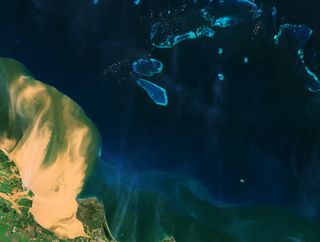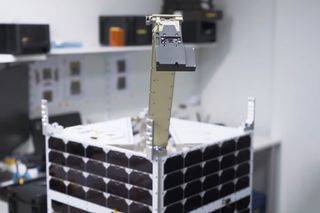Satellite snaps gorgeous 4K selfie over Great Barrier Reef (video)
It literally used a selfie stick in space.
A new spacecraft selfie shows the machine in glorious 4K resolution above Australia's Great Barrier Reef.
NanoAvionics, a satellite company based in the United States and United Kingdom, released a high-definition video from space Wednesday (June 28) showing their MP42 microsatellite flying 342 miles (550 km) above the reef and the Coral Sea which lies off the northeast coast of Australia.
The "immersive" view of Earth, captured with the assistance of a selfie stick, is the first such high-definition view of a full satellite backdropped by our planet, company officials wrote in a release that same day.
Featuring the reef as the backdrop was not coincidental. "We wanted to highlight the vulnerability of our planet and the importance of Earth observation by satellites, especially for monitoring environment and climate changes," Vytenis Buzas, co-founder and CEO of NanoAvionics, said in the company statement.

The Great Barrier Reef is the largest structure on Earth made by living organisms, spanning some 133,000 square miles (344,400 square kilometers), according to previous information from NASA's Jet Propulsion Laboratory (JPL).
The agency studied the Great Barrier Reef in 2016 as part of its airborne CORAL mission (COral Reef Airborne Laboratory), aiming to provide a more comprehensive dataset of damage to the coral than available in space missions at the time.
Coral reefs worldwide, including this one, are all showing serious signs of decline amid human-driven global warming. Reefs are "degrading at alarming rates", JPL stated, as they are failing to replace themselves with flat beds of algae and sand as they are supposed to.
Get the Space.com Newsletter
Breaking space news, the latest updates on rocket launches, skywatching events and more!

While NanoAvionics had environmental reasons for featuring this image, the recording had engineering utility as well.
While taking the selfie, officials wrote, the satellite's camera tested and verified satellite operations for a payload controller that aims to process some data in space before sending it down to Earth. (Such a process saves valuable time when assessing fast-changing areas on the planet.)
"The company anticipates more future usages of real satellite footage, live and recorded, such as deployment confirmation, fault detection, micro-meteorite impacts and educational purposes," NanoAvionics officials stated.
The spacecraft launched with about 40 other small satellites aboard a SpaceX Falcon 9 rocket on April 1, flying the satellites to orbit on a mission called Transporter-4.
Follow Elizabeth Howell on Twitter @howellspace. Follow us on Twitter @Spacedotcom and on Facebook.
Join our Space Forums to keep talking space on the latest missions, night sky and more! And if you have a news tip, correction or comment, let us know at: community@space.com.

Elizabeth Howell (she/her), Ph.D., is a staff writer in the spaceflight channel since 2022 covering diversity, education and gaming as well. She was contributing writer for Space.com for 10 years before joining full-time. Elizabeth's reporting includes multiple exclusives with the White House and Office of the Vice-President of the United States, an exclusive conversation with aspiring space tourist (and NSYNC bassist) Lance Bass, speaking several times with the International Space Station, witnessing five human spaceflight launches on two continents, flying parabolic, working inside a spacesuit, and participating in a simulated Mars mission. Her latest book, "Why Am I Taller?", is co-written with astronaut Dave Williams. Elizabeth holds a Ph.D. and M.Sc. in Space Studies from the University of North Dakota, a Bachelor of Journalism from Canada's Carleton University and a Bachelor of History from Canada's Athabasca University. Elizabeth is also a post-secondary instructor in communications and science at several institutions since 2015; her experience includes developing and teaching an astronomy course at Canada's Algonquin College (with Indigenous content as well) to more than 1,000 students since 2020. Elizabeth first got interested in space after watching the movie Apollo 13 in 1996, and still wants to be an astronaut someday. Mastodon: https://qoto.org/@howellspace
